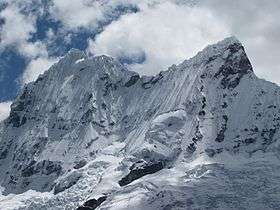Chacraraju
| Chacraraju | |
|---|---|
 | |
| Highest point | |
| Elevation | 6,108 m (20,039 ft) [1] |
| Coordinates | 8°59′36″S 77°36′54″W / 8.993261°S 77.614975°WCoordinates: 8°59′36″S 77°36′54″W / 8.993261°S 77.614975°W |
| Geography | |
 Chacraraju Location in Peru | |
| Parent range | Cordillera Blanca, Andes |
| Climbing | |
| First ascent | Chakrarahu Oeste: Lionel Terray et al (31 July 1956) - Chakrarahu Este: Lionel Terray et al. 5 August 1962 |
Chacraraju[2][1][3][4] or Chakraraju[5] (possibly from Quechua chakra little farm ; field, land sown with seed, rahu snow, ice, mountain with snow)[6][7][8] is a mountain in the Cordillera Blanca in the Andes range of Peru. The mountain has two distinctive peaks Chacraraju Oeste (west summit; 6,108 metres (20,039 ft)) and Chacraraju Este (east summit; 6,001 metres (19,688 ft)).[5] Chacraraju is located in the Ancash Region, Huaylas Province, Caraz District, and in the Yungay Province, Yungay District.[9] It lies south and southeast of Pirámide. Lake Parón and the little Lake Chacra lie northwest of the mountain.[2] The peak is accessible from the Pisco base camp at Cebollapampa.[1]
Climbing
Chakrarahu is considered the steepest and the most difficult-to-climb six-thousander in the Andes.[10] Although by no means worked out, the south face of the mountain has a quite staggering number of steep and difficult lines, enough to bear comparison with areas such as the south face of Mont Blanc du Tacul for maturity. The north side bore the brunt maturity of early development but still retains the greatest potential.
A French expedition led by Lionel Terray first climbed the mountain on 31 July 1956 (Chakrarahu Oeste) and on 5 August 1962 (Chakrarahu Este) on what after have become the normal routes (northeast face and northeast ridge). Greg Mortimer was badly injured during a later attempt to climb the mountain.[11]
Some of the routes are amongst the most desperate of the Cordillera Blanca and probably of the entire Andes. All the routes take several days and involve hanging bivouacs. First ascents to the ridge linking the east and west summits are recorded. Not all the parties are able to reach the true summits of Chakrarahu Este and Oeste, because this requires traversing below the cornices and obviously increases the seriousness of the climbs.
See also
References
- 1 2 3 Biggar, John (2005). The Andes: A Guide for Climbers. Andes. p. 68. ISBN 9780953608720.
- 1 2 Alpenvereinskarte 0/3a. Cordillera Blanca Nord (Peru). 1:100 000. Oesterreichischer Alpenverein. 2005. ISBN 3-928777-57-2.
- ↑ Peru 1:100 000, Corongo (18-h). IGN (Instituto Geográfico Nacional - Perú).
- ↑ "Nevado Chacraraju". Inventario Turístico del Perú (in Spanish). MINCETUR. Retrieved June 28, 2016.
- 1 2 Ricker, John (1977). Yuraq Janka: A Guide to the Peruvian Andes. The Mountaineers Books. p. 76. ISBN 9781933056708.
- ↑ Teofilo Laime Ajacopa, Diccionario Bilingüe Iskay simipi yuyayk'ancha, La Paz, 2007 (Quechua-Spanish dictionary)
- ↑ lema.rae.es Diccionario de la lengua española, retrieved on October 21, 2013
- ↑ babylon.com
- ↑ escale.minedu.gob.pe - UGEL map of the Huaylas Province (Ancash Region)
- ↑ Cathy Biggar; John Biggar (21 May 2001). The Andes: A Trekking Guide. Andes. p. 61. ISBN 978-0-9536087-1-3. Retrieved 26 January 2013.
- ↑ "Interview with Greg Mortimer (ABC1 Monday 6:30pm)". Australian Broadcasting Corporation (ABC). 2009-10-05. Retrieved 2012-01-26.